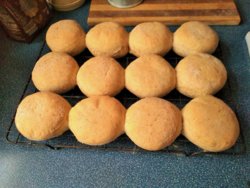So the bread I've been making tastes really good, but isn't rising as well as I think it should.
Here's my steps:
Stir 2 teaspoons of dried yeast and 2 teaspoons of sugar into 150ml of tepid water.
While that's starting to froth a little, mix 450g of flour (whatever combination of white and wholemeal) and a teaspoon of salt
When the yeast has a bit of froth going, mix in with the kneading hook on the mixer
Add another 150ml of tepid water and let it knead for 5 minutes
Cover with oiled clingfilm and leave in a warm place for an hour or so until roughly doubled
Knock back for 30 seconds and shape into a loaf in a tin
Cover with the clingfilm again and wait until it's risen a couple of cm above the top of the tin
Bake for 30 minutes at 200
So, it just doesn't want to rise much more when it's in the oven.
I'm wondering if I'm knocking back too much - might try skipping that. Any other tips?
Thinking about it, when I was using the sachets of yeast I think it was rising better, so maybe I'm not using enough yeast. I'm using Allinson Easy Bake Yeast
View attachment 456987



